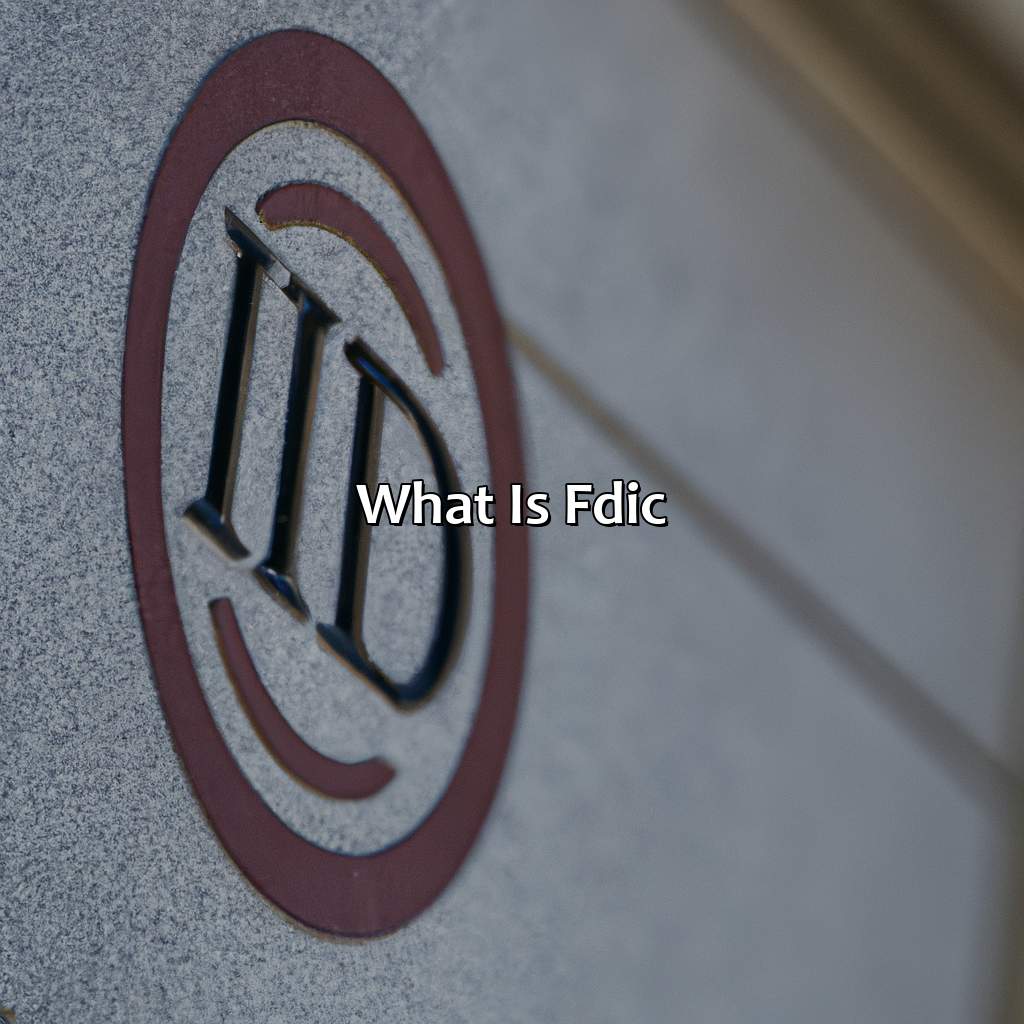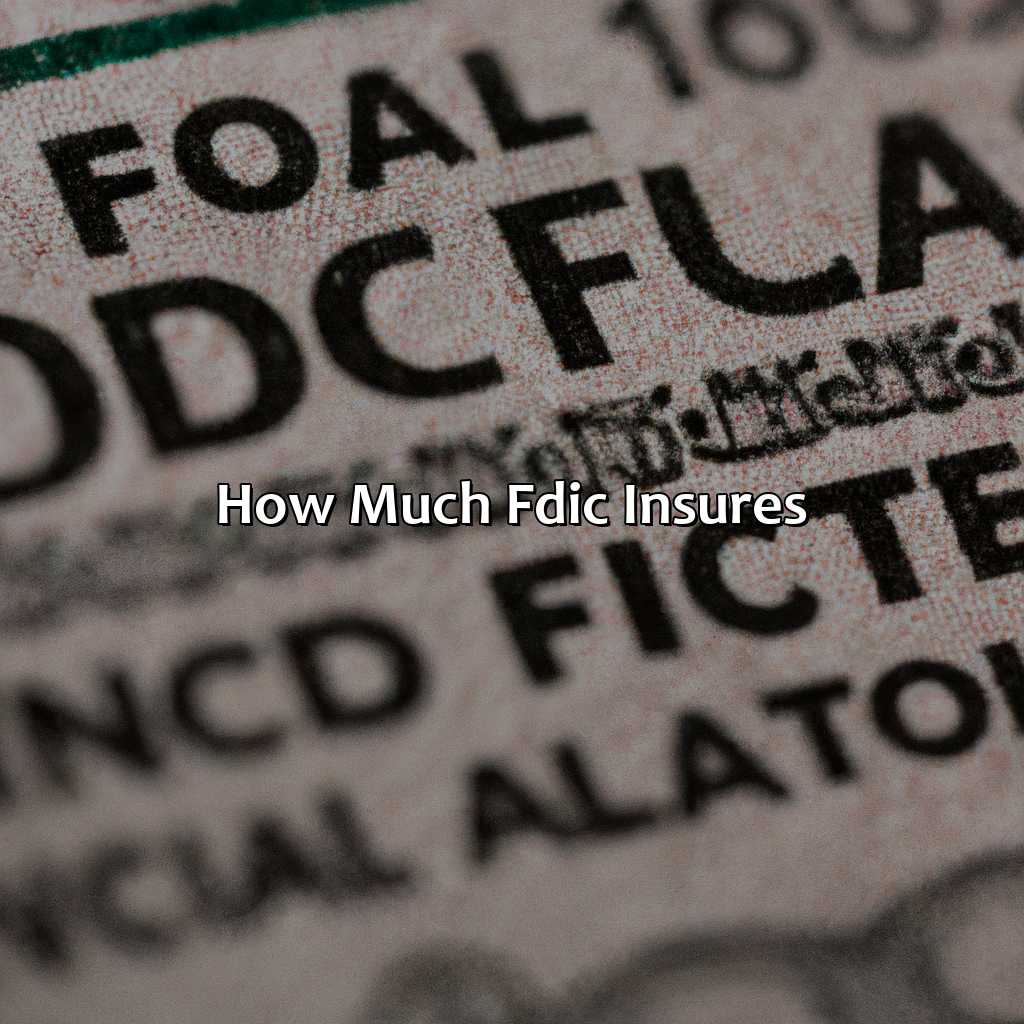Which Investment Is Insured By The Fdic?
Key Takeaway:
- The FDIC insures certain types of bank deposits up to $250,000 per depositor and per bank. This includes savings accounts, checking accounts, money market accounts, and certificates of deposit (CDs).
- Investments such as stocks, bonds, mutual funds, and annuities are not insured by the FDIC. It is important to research and understand the risks and potential returns of any investment before investing.
- The FDIC provides an important safety net for depositors in case of bank failure or economic instability. By choosing FDIC-insured accounts, depositors can protect their money and feel more secure about their financial future.
Are you considering a high-yield certificate of deposit but want to make sure your money is secure? Knowing which investments are insured by the FDIC can give you the peace of mind you need when it comes to investing your hard-earned money. You’ll want to learn about the FDIC and which of your investments are eligible for federal deposit insurance.
What is FDIC?
FDIC or the Federal Deposit Insurance Corporation is an independent US government agency that provides insurance and guarantees deposits in banks and savings associations. It was created during the Great Depression in 1933 to restore trust in the banking system and to protect depositors from losing their savings.
The FDIC insures deposits up to $250,000 per depositor per insured bank and also supervises and regulates all FDIC-insured institutions to ensure their safety and soundness.
In simple terms, FDIC is a federal agency that safeguards people’s money deposited in banks and savings associations. It provides deposit insurance up to a certain limit to protect depositors from bank failures and other financial risks. The FDIC’s primary goal is to maintain stability and public confidence in the banking system, thereby promoting economic growth and maintaining financial stability.
It is worth noting that the FDIC only insures deposit accounts such as savings accounts, checking accounts, money market accounts, and CDs, among others. Other investment products such as stocks, bonds, mutual funds, and annuities are not insured by the FDIC. Therefore, it is crucial to understand the scope of FDIC’s insurance coverage and review the terms and conditions of your investment products before making any investment decisions.
According to a recent report by the FDIC, the agency had a total of $117.9 billion in insurance funds as of June 30, 2021, to protect depositors in the event of bank failures. This demonstrates the FDIC’s commitment and ability to ensure the safety and stability of the banking system, and the trust and confidence it has garnered from the public over the years.

Image credits: retiregenz.com by Harry Woodhock
Which Investments are Insured by FDIC?
Uncover which investments FDIC insures. Investigate Bank Deposits, Saving Accounts, Checking Accounts, Money Market Accounts, and Certificates of Deposit (CDs). Learn more about the accounts FDIC insures. Plus, explore the advantages these accounts offer.

Image credits: retiregenz.com by Joel Woodhock
Bank Deposits
Bank savings and checking accounts are among the most common types of deposits insured by the FDIC. These accounts provide a safe and secure place to store money while earning interest.
| Account Type | Insurance Limit |
| Checking Accounts | $250,000 per depositor, per insured bank |
| Savings Accounts | $250,000 per depositor, per insured bank |
| Certificate of Deposit (CD) Accounts | $250,000 per depositor, per insured bank |
Certain individual retirement accounts (IRAs) such as Roth and traditional IRAs are also insured by the FDIC. It is important to note that investment options such as stocks, bonds and mutual funds are not protected under FDIC insurance.
Did you know that on December 28, 2020, Congress passed a law increasing the deposit insurance coverage from $250,000 to $500,000 for all insurable account types until December 31, 2025?
If your savings account is insured by FDIC, at least you can rest assured that your money is safe, even if your self-control isn’t.
Saving Accounts
Certified FDIC accounts ensure the safety and security of your deposited money. These protected accounts include various types of savings accounts, including individual savings, joint savings, certain retirement accounts, money market accounts, and certificate of deposit accounts. Each has its specific requirements to be FDIC-insured.
- Individual savings is a standard type that enables individuals to store cash safely in banks.
- Joint saving options have multiple account holders for shared funds and require that each holder’s interest must be equal in the account.
- Specific requirements apply to retirement savings based on their types: traditional IRA, Roth IRA, Simplified Employee Pension (SEP), and Savings Incentive Match Plan for Employees (SIMPLE).
- Money market deposit accounts allow larger balance customers more significant interest rates than regular savings, while still providing FDIC protection.
- Certificate of deposit accounts limit withdrawals before maturity but offer higher rates of return.
It’s essential to check with banks’ official platforms regarding their offers since not all bank products may be eligible for FDIC insurance coverage. Remember to read financial institution regulations and terms carefully to know exactly how much FDIC protection you’re receiving and educate yourself on ways to protect your assets in other necessary ways for comprehensive financial risk management.
Your checking account may not be the most exciting investment, but at least you won’t have to worry about losing your money to a Nigerian prince.
Checking Accounts
As you consider opening an account, it is crucial to know which accounts are insured by FDIC. Accounts that are classified as demand deposits are eligible for FDIC insurance coverage up to $250,000 per depositor. These accounts include checking accounts, interest-bearing transaction accounts, and negotiable order of withdrawal (NOW) accounts.
Checking accounts offer a simple way to access your funds while providing the convenience of writing checks or using debit cards for purchases. These types of accounts can include basic checking, student checking, joint checking, and business checking.
It is important to note that not all types of deposits are covered by FDIC insurance. Money market deposit accounts (MMDAs), certificates of deposit (CDs), and investment products such as stocks and bonds are not included in the coverage provided by the FDIC.
In 1933 when the stock market crashed due to bank failures caused by reckless investing, President Franklin Delano Roosevelt created the Federal Deposit Insurance Corporation (FDIC). The purpose was to restore trust in banks among depositors and quickly protect their savings in case of bank failures. Today FDIC continues its mission of safeguarding American’s money while preserving confidence in our banking system.
Investing in money market accounts is like playing it safe in a casino, sure the returns may be low, but at least you won’t be selling organs to pay your debts.
Money Market Accounts
Money Market Accounts offer a higher interest rate compared to traditional savings accounts. They are ideal for those who want to earn more interest but still have access to their funds.
Unlike other investments such as stocks and bonds, Money Market Accounts provide liquidity, meaning they can be accessed at any time without penalty. This makes them reliable during times of emergencies.
Money Market Accounts also have a low-risk level because they invest in short-term debt securities from the government or corporate entities. This reduces the possibility of losing money.
It’s essential to note that FDIC only insures up to $250,000 per depositor per account ownership type in case of bank failure or closure. It is recommended that investors keep an eye on their deposits and if needed, open multiple accounts with different banks to ensure complete insurance coverage.
To maximize the benefits of Money Market Accounts, investors should focus on finding institutions with competitive interest rates and low fees. Additionally, maintaining a sizeable minimum balance can lead to better rates and fewer charges.
Investing in Money Market Accounts offers security and reliability while providing decent returns on investment. With reasonable research and careful consideration towards individual needs and preferences, this option can serve as an excellent alternative for saving money.
Lock in your money like it’s your ex’s Netflix account with CDs – and rest easy knowing they’re insured by the FDIC.
Certificates of Deposit (CDs)
Investments with FDIC insurance protection – Fixed-term accounts with a predetermined interest rate known as Time-Deposits. These can be specifically CDs, which the bank holds for a set term in your name. In case of bank failure, the basic insurance limit of $250,000 per depositor per insured bank will be applicable.
CDs have a maturity date by which the deposit’s full value can be withdrawn along with the accrued interest. In case you need to withdraw early, there is usually an early-withdrawal penalty fee that varies depending on the invested amount and period. Hence, investors should thoroughly evaluate their financial flexibility before investing in CD options.
Looking for a secure investment option to guarantee the safety of your money? CDs are one of the most viable solutions to ensure a safe haven for your funds while earning decent returns at low risks. Hop onto this avenue while earning peace of mind and steady income benefits!
The FDIC may not be able to insure you against bad life decisions, but it can at least protect up to $250,000 of your bad investment decisions.
How much FDIC Insures?
To know the scope of your FDIC coverage, you need to know the limits that apply to your insured deposits. We will dive into the three sub-sections of the FDIC coverage. These are:
- Single Account Limit
- Joint Account Limit
- Business Account Limit

Image credits: retiregenz.com by David Duncun
Single Account Limit
When it comes to FDIC, the maximum amount of deposit insurance is known by the term ‘Insurance Limit for a Single Account.’ The limit is currently set at $250,000 per depositor per account ownership category. This means that if anyone holds an individual account in a bank and has deposited an amount less than or equal to $250,000 in that account, then it will be insured by the FDIC.
Moreover, if someone holds several accounts with different ownership categories such as joint accounts or retirement accounts in the same bank, then each account’s insurance limit will be $250,000. Therefore, if one person has three individual accounts at the same bank with a deposit of $100,000 in each account, then all three accounts would be covered by FDIC insurance.
It is essential to note that FDIC insurance is not based on account type but rather on each unique account holder’s ownership category. Therefore, any deposits made above the $250,000 limit will not be insured by FDIC and can result in losses.
Ensure your deposits are insured by keeping them within the specified single account limit set by FDIC. Don’t miss out on securing your hard-earned money and avoid unnecessary financial risks.
When it comes to joint accounts, it’s important to remember that sharing is caring, but exceeding the FDIC insurance limit is daring.
Joint Account Limit
If you’re wondering about the maximum coverage for a shared account, don’t worry. The ‘Combined Account Limit’ applies here, and it ensures that you’re protected under the same conditions as an individual account.
Here’s an informative table that illustrates the FDIC insured amounts for various account types:
| Account Type | Coverage Limit |
|---|---|
| Individual Accounts | $250,000 per depositor, per FDIC-insured bank, per ownership category |
| Joint Accounts | $250,000 per co-owner, per FDIC-insured bank. |
| Trust Accounts | $250,000 per owner for each beneficiary. The coverage limit depends on the number of beneficiaries and their relationship with the owner(s). |
It’s important to note that these limits apply to all accounts in your name in one bank. It doesn’t matter if you have separate or shared accounts – the coverage remains capped at $250k per depositor.
If you’re interested in keeping your hard-earned savings safe and sound, it’s vital to understand how FDIC insurance works. Now that you know about limits for both individual and joint accounts come up with an investment plan and avoid leaving any funds uninsured!
Business Account Limit
Business Account Coverage by FDIC
Business accounts are fundamental to most commercial activities, but it is crucial to understand the Business Account Coverage provided by FDIC. Here’s what you need to know:
- FDIC insures up to $250,000 per depositor per account ownership category.
- A single business can have multiple “accounts” based on different account ownership categories. Each of these accounts will be insured up to $250,000.
- It is vital to make sure that each account falls within a different ownership category for higher insurance coverage.
- The FDIC conducts regular and thorough bank examinations to ensure banks’ compliance with federal regulations regarding maximum deposit insurance coverage.
As a business owner, understanding Business Account Coverage is significant in making educated financial decisions for your business. By having information about the amount of deposit insurance coverage available under law, you can best protect your company’s funds.
A true story indicates the importance of understanding FDIC-insured coverage – one small construction company chose their bank without considering covering the cost via FDIC, which led to losing thousands due to an unexpected event when their bank failed. Therefore, before choosing a bank for any kind of account management services, it’s essential to investigate that the institution provides reliable security through FDIC-insured deposits for situations such as this one.
Five Facts About Investments Insured by FDIC:
The Federal Deposit Insurance Corporation (FDIC) is an independent US government agency that provides deposit insurance to protect depositors in case their bank fails. (Source: FDIC)
The FDIC insures deposits up to $250,000 per depositor, per insured bank, for each account ownership category. (Source: FDIC)
The FDIC covers deposits in checking, savings, CDs, and money market accounts, among others, at FDIC-insured banks. (Source: FDIC)
Investments in stocks, bonds, mutual funds, and annuities are not insured by the FDIC. (Source: FDIC)
The FDIC was created in response to the banking crisis of the Great Depression and has been insuring deposits since 1934. (Source: FDIC)
FAQs about Which Investment Is Insured By The Fdic?
Which investment is insured by the FDIC?
Deposits in FDIC-insured banks and savings institutions are insured up to $250,000 per depositor, per FDIC-insured bank or savings institution, for each account ownership category.
What types of accounts are FDIC-insured?
All types of deposit accounts, including checking accounts, savings accounts, money market deposit accounts (MMDAs), and certificates of deposit (CDs), are FDIC-insured.
What is not covered by FDIC insurance?
FDIC insurance does not cover investments in stocks, bonds, mutual funds, life insurance policies, annuities, or municipal securities, even if these investments were bought from an FDIC-insured bank.
Is FDIC insurance free?
Funding for the FDIC comes from premiums paid by banks and savings institutions. There is no direct cost to depositors for FDIC insurance coverage.
What happens if my bank fails?
If your bank fails, the FDIC will step in as the receiver and will either reimburse you for your insured deposits or transfer your accounts to another insured bank. Usually, this process happens within a few days.
How do I know if my bank is FDIC-insured?
Most banks prominently display the FDIC logo on their website and in their branches. You can also check if your bank is FDIC-insured by visiting the FDIC’s website and using their BankFind tool.
 Checkout this IRS Loophole
Checkout this IRS Loophole 
